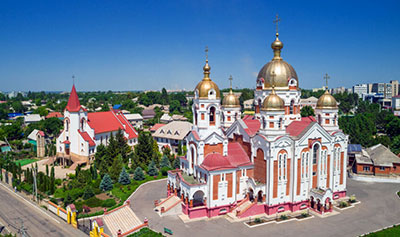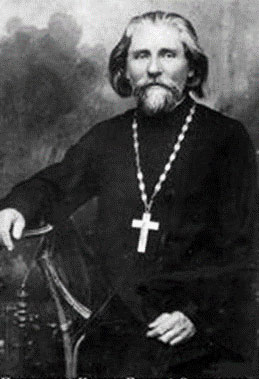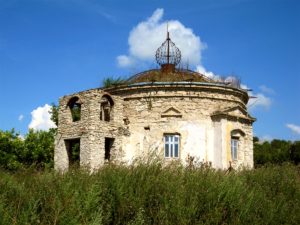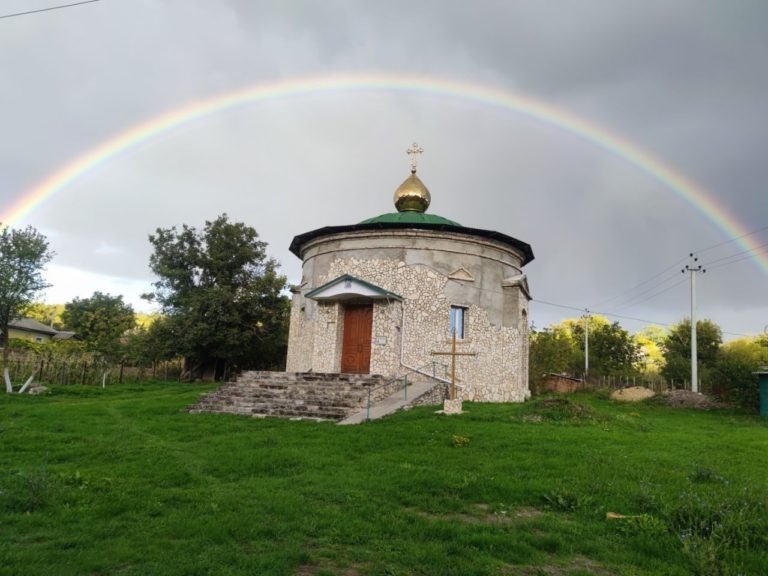History of the Church in Transnistria
Culture is a complex and multifaceted phenomenon, which permeates all spheres of the life and activities of society and a person. There is a distinction between material and spiritual culture. Spiritual culture refers to science, art, morality, religion. The culture of Transnistria was always distinguished by its vivid variety. It was an intermingling of the traditions, customs, crafts, and forms and genres of art of the peoples inhabiting the region.
The elements of material and spiritual culture formed a special mentality in the population, based upon the Orthodox faith, mutual respect, and spiritual mutual enrichment of peoples of diverse nationalities. One of the most ancient forms of culture is religion. It is well-known that in the past the church was the main institute in which a person was reared. It occupied a prominent position in social work, encompassing a person's basic needs – religious, social, cultural, and educational.
The church preserved all amassed knowledge, principles, traditions, and customs, and for centuries allowed many generations to keep their individuality and strengthen spiritual interrelations.
During the Middle Ages, Transnistria was part of the Kievan Rus, and later of the Galician-Volyn Principality. For a long time part of its territory was under the influence of the Tatars and Turks, and afterwards under the influence of the Catholic Polish-Lithuanian Commonwealth. Nevertheless, Orthodox life was never extinguished.
Churches in Transnistria
Today there are about 70 churches and 2 monasteries open in Transnistria. The largest church in the Tiraspol-Dubossary Diocese was recently built in the city of Rybnitsa. In terms of its prominence, the Archangel Michael's Cathedral in Transnistria is compared with the Church of Christ the Saviour in Moscow. The church is the adornment of the city and of the entire republic.

There is also a church in the village of Popenki, which is located on the shore of the Dniester River. On the basis of the parish register (in Polish) that was being kept in the church from the end of the past century, one can conclude that in 1790 the village was an independent parish, whose parishioners, together with their priest Ioann Gadzinsky, were Uniates, and it was only as of 1795 that the village became an Orthodox parish. From that time all baptismal certificates and other church documents were written in Russian and signed by an Orthodox priest.
In the 30s of the 18th century, the village of Zozulyany was added to the parish of the Popenki village. As can be seen from documents, prior to the building of the current church the parish had a church in honor of the St. Archangel Michael. The construction was begun in 1834 and finished in 1857, but then the church was consecrated in honor of the holy Apostle John the Theologian and not in honor of the Archangel Michael, as had been proposed during the founding of the church. According to old-timers, this occurred because the main builder of the church, the landowner Ioann Vizersky, wished the newly-built church to be consecrated in honor of his patron saint. The church exists in the same form as it was originally set up, except that it was renovated in 1870 and 1888 on donations from parishioners.
One of the major issues of the territory's religious life in 1944-1946 was the obvious shortage of clergymen. It is well-known that the Romanian occupying powers made the Church an instrument of ideological control and Romanization of the local population. For this purpose 400 priests were assigned to the parishes of Transnistria. An absolute majority of them fled to Romania when the battlefront came closer, leaving their flock without spiritual care. In consequence, as of early May 1945, only 20 parishes remained active in five Transnistrian districts, while 46 were empty. In connection with this situation, the religious communities of the villages of Mokra, Popenki, and Zozulyany of the Rybnitsky district appealed to the Commissioner with requests to either give them a priest, or allow them to find one themselves and renew services in the churches. All these appeals were satisfied.
As of 1984 the church was re-equipped as a museum and later as a store. As was already mentioned above, in the 30s of the 18th century the Zozulyany village was added to the parish of the Popenki village and to-date remains part of the village Council.
Church of Saint Paraskeva of Serbia

Data taken from the archives of the 2nd diocesan district of the Balti county of the Kamenets-Podolsk Governorate confirms the existence of a church in the Zozulyany village as of 1709, which emerged in conditions of an intensive assault upon Orthodoxy by Catholicism and Uniatism. The first church was built from clayed rods covered with bulrush. By the 40s of the 19th century the old wattle church fell into disrepair, and a council of peasants decided to build a new round stone church. This type of church (rotundal) was the only one of its kind in Transnistria. The rotundal type of church is one of the most ancient and original examples of church architecture. The rotunda is a round construction. It is both a symbol of eternity and of the world as a creation of God and man! And that is not the entire description of it, since this symbol is quite multifaceted.
How graphically the cupola of the church corresponds to the head of a Russian warrior! The helmet and cupola are of the same form, the armor on his head is copied in the cupola's cylindrical shape, while the body armor is copied in the strength and structure of the church walls, etc. It should be remembered that a Christian is a warrior of Christ, which once again emphasizes the depth of the church image. Many times the church of the Zozulyany village blessed warriors going off to war. The circle is an amazing figure. It alone is regarded as being perfect. One of its properties is that it touches upon a surface at only one point. How this reminds us of a Christian, who must touch upon earthly being at only the one point of his earthly bodily existence. The circle represents eternity.. This is a well-known formula. It is a symbol of both eternity and the world, as the creation of God and man. This is how the meaning of the new church was looked upon. It should be noted that there are only 17 churches in the entire world that are round in shape and similar to the one in Zozulyany. The church was built through the efforts of the parish priest at that time, Simeon Lozinsky, on money donated by the parishioners and the local landowner.
The church of St. Paraskeva of Serbia was built and consecrated in 1845. The church had a two-tiered wooden iconostasis, with icons painted partly on cloth and partly on wood. In 1895 a stone narthex was built onto the church, with carved columns and glass doors and windows, and a new stone staircase with brick ornamental railings was added to the entrance.
The period of persecution of the Church

In 1921-1929 there was a period of persecution of clergymen and the Church as a whole. Transnistria was very hard hit by atheistic propaganda. This was when the most difficult and tragic period in the history of the village church began. For a single incautious word that was unacceptable to the authorities, any plain believer could end up on the list of “enemies of the people,” not to mention the clergymen, who were subjected to the cruel repressions of red terror – they were thrown into prisons and camps, sent into exile, or executed.
The reverend Protopriest Georgiy Viktorovich Klochan became a victim of this terror.
Father Georgiy was born in 1880 in the village of Berezki-Chechelnicheskiye in the Podolsk Governorate, in a deeply religious peasant family. He received his education in a teachers' seminary, and after graduation worked as a school teacher. He began serving in the Zozulyany village as of 1921.
From the very first days of his pastoral service in Zozulyany, Father Georgiy and his family were the recipients of warm attention and love from the parishioners, but on the part of the authorities they immediately experienced a hostile attitude towards themselves. In 1923 Father Georgiy was arrested several times for “counterrevolutionary activity.” In 1924, at the demand of the authorities, he was evicted from the rectory together with his family. Only the support of his parishioners saved Father Georgiy's family from hunger. The authorities strove to get rid of Father Georgiy and threatened to close down the church. The Komsomol youth attacked Father Georgiy after the evening services and beat him up. The parishioners had to escort him home from church.
Only the support of his parishioners saved Father Georgiy's family from hunger. The authorities strove to get rid of Father Georgiy and threatened to close down the church. The Komsomol youth attacked Father Georgiy after the evening services and beat him up. The parishioners had to escort him home from church.
In early 1938 the searches and arrests began. Within 24 hours all exiled clergymen were imprisoned. The court sentenced Father Georgiy to imprisonment as well. In prison he was subjected to torture, and in 1938 he died a martyric death as a confessor of faith in Christ. Now Father Georgiy has been included among the new martyrs and has been canonized.
In 1929 the Zozulyany church of St. Paraskeva of Serbia was closed down. The closure of a church signifies not only the loss of a village's center of religious spirituality and culture, but of its history as well, since it was specifically the church which kept a registry of births, baptisms, marriages, and other important events in the life of tens of generations of villagers.
The attitude towards the church changed to a great extent during the period of the Great Patriotic War. All Orthodox parishes located on occupied territory were subordinated to the jurisdiction of the Romanian Patriarchate. Some of the Orthodox churches were reopened by the Romanian occupiers; however, churches in honor of Russian saints were renamed in honor of the most venerated saints in Romania. The restoration of church life in Transnistria was done for the purpose of Romanizing this region.. Thus the church in Zozulyany was reopened by the Romanians because it was in honor of St. Paraskeva of Serbia, a saint greatly venerated in Romania. Not far from the church the Romanians constructed a building where services were likewise held and traditional rites were observed. Under their rule no work was done on restoring the ruined church..
But beginning with 1955-1956, a new wave of destruction swept across the diocese. Almost all churches were closed down and demolished. Such an active crackdown as was observed during the period of Khrushchev's “thaw” was not known by the Russian Orthodox Church of Transnistria even in the worst Stalinist times. After Khrushchev's persecution, only 4 parishes survived in Transnistria.. После хрущёвских гонений в Приднестровье уцелело только 4 прихода.
The round church of St. Paraskeva of Serbia was also destroyed during this period. The church was first demolished and then burned down. It was extremely painful to look at the church of St. Paraskeva of Serbia. On the site where the church used to be, there now stood a round building without a roof. The windows yawned emptily, while an almost meter-high wall of weeds surrounded the structure. Total desolation and destruction. On the site where the holy altar table used to stand, there was now a gaping hole with lumps of concrete inside.
Icon of St. Paraskeva of Serbia
Three of the church's large and valuable icons miraculously remained intact. These were an icon of St. Paraskeva of Serbia, an icon of St. Seraphim of Sarov, and an image of Three Saints. In 1990, after its reconstruction, the church of St. John the Theologian was reopened anew. The icons from the church of St. Paraskeva of Serbia that had remained intact were given to the church of St. John the Theologian, where to this day they remain on the walls of the church.

On the scroll which St. Paraskeva, also called Paraskeva Friday, holds in her left hand, one can read some prayers, while with her right hand the Saint presses a cross to her breast. The icon depicting St. Paraskeva not only attests to her spiritual endeavors, but in the language of symbols reveals the essence of desert-dwelling service on earth. The head of St. Paraskeva is enfolded in a luminous halo, while the celestial powers, represented by flying angels, are lost in admiration before the beauty of her nature and crown the Saint not only with a golden wreath, but with a precious crown as well.
Among the holy women of the Orthodox Church, St. Paraskeva Friday occupies a place just as honorable and important as that occupied by St. Nicholas the Wonder-worker among the Holy Fathers. If one looks at a map of post-Mongolian Russia, one will see an amazing picture. It will turn out that churches in honor of St. Paraskeva were built in all corners of the country.
The icon is an integral part of Orthodox tradition, and it is difficult to imagine an Orthodox church and service and a home of an Orthodox person and his life without it. When a person is born or dies, embarks upon a long journey or begins some affair, his life is always accompanied by a holy image, an icon.
On the path to restoration

In 1998 a new stage of the Orthodox history of the area began in Transnistria, which was marked by an increase in the construction and restoration of Orthodox churches.
In late March of 2001, a letter came to the diocesan administration of the Tiraspol-Dubossary Diocese from the Orthodox residents of the Zozulyany village, with an appeal to His Beatitude Bishop Justinian to help with the restoration of the church of St. Paraskeva of Serbia. There was hope that the state structures of the Rybnitsky district and businessmen would take part in the restoration. In 2003-2004 great assistance in the restoration of the Zozulyany church was provided by U.S. citizen Glafira Georgiyevna Barnatny, who was the daughter of the former priest of the Zozulyany church, Father Georgiy Klochan. Father Fedor, rector of the church of St. John the Theologian in the Popenki village, also contributed to the restoration of the church. He did not remain indifferent to the fate of the half-demolished building that was in a state of disrepair. Thanks to his efforts, and with the support of the villagers, it became possible to restore the church windows and doors, partially plaster the walls, and begin services. Father Fedor was able to invigorate the church and inspire the villagers with hope of its complete restoration and the conduct of all requisite services. In 2004, by decree of the Supreme Council of the Transnistrian Moldavian Republic, the Zozulyany village church of St. Paraskeva of Serbia was included in the state registry of historical monuments of culture and architecture.. In 2004, by decree of the Supreme Council of the Transnistrian Moldavian Republic, the Zozulyany village church of St. Paraskeva of Serbia was included in the state registry of historical monuments of culture and architecture.
It is now the twenty-first century – a century of the spiritual rebirth of our country. Old churches are being restored and renovated everywhere.
The history of a church is also the history of its village, which each of its residents must know. In acquainting oneself with the historical facts of the life of the founders of the church, its priests, and those who with great effort restored the demolished church, one learns to understand the continuity of time and the succession of generations, and to feel one's involvement in historical events. Respect for the monuments of olden times and a considerate attitude towards the faith of one's ancestors is one of the aspects of a man's moral characteristics. It allows the young generation to feel itself the inheritor of the past and to realize its responsibility to the future.
The church is a symbol of peace, goodness, friendship, love, and mutual understanding. Years may pass, but a village in which there is a church will continue to live. Its descendants will venerate their own land and will not search for happiness in foreign parts. And if a person is alone in this world, the church will grant him the faith, love, and hope that help people find strength and confidence to do good deeds.
The Orthodox Christians of our village long to hear the ringing of bells of the restored church on the picturesque shore of the Dniester River. May once again church hymns be heard therein, marriages blessed, children baptized, and may the solemnity of the services and the beauty of the icons delight the souls of people and make them good and bright.
May the church of St. Paraskeva of Serbia become the center of the village's spirituality, culture, and history.


